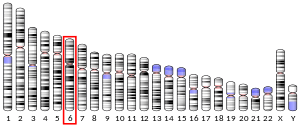PEX6
Peroxisome assembly factor 2 is a protein that in humans is encoded by the PEX6 gene.[5][6]
Interactions
PEX6 has been shown to interact with PEX1[7][8] and PEX26.[9]
References
- 1 2 3 GRCh38: Ensembl release 89: ENSG00000124587 - Ensembl, May 2017
- 1 2 3 GRCm38: Ensembl release 89: ENSMUSG00000002763 - Ensembl, May 2017
- ↑ "Human PubMed Reference:".
- ↑ "Mouse PubMed Reference:".
- ↑ Yahraus T, Braverman N, Dodt G, Kalish JE, Morrell JC, Moser HW, Valle D, Gould SJ (Aug 1996). "The peroxisome biogenesis disorder group 4 gene, PXAAA1, encodes a cytoplasmic ATPase required for stability of the PTS1 receptor". EMBO J. 15 (12): 2914–23. PMC 450231
 . PMID 8670792.
. PMID 8670792. - ↑ "Entrez Gene: PEX6 peroxisomal biogenesis factor 6".
- ↑ Tamura, S; Shimozawa N; Suzuki Y; Tsukamoto T; Osumi T; Fujiki Y (Apr 1998). "A cytoplasmic AAA family peroxin, Pex1p, interacts with Pex6p". Biochem. Biophys. Res. Commun. UNITED STATES. 245 (3): 883–6. ISSN 0006-291X. PMID 9588209. doi:10.1006/bbrc.1998.8522.
- ↑ Geisbrecht, B V; Collins C S; Reuber B E; Gould S J (Jul 1998). "Disruption of a PEX1-PEX6 interaction is the most common cause of the neurologic disorders Zellweger syndrome, neonatal adrenoleukodystrophy, and infantile Refsum disease". Proc. Natl. Acad. Sci. U.S.A. UNITED STATES. 95 (15): 8630–5. ISSN 0027-8424. PMC 21127
 . PMID 9671729. doi:10.1073/pnas.95.15.8630.
. PMID 9671729. doi:10.1073/pnas.95.15.8630. - ↑ Matsumoto, Naomi; Tamura Shigehiko; Fujiki Yukio (May 2003). "The pathogenic peroxin Pex26p recruits the Pex1p-Pex6p AAA ATPase complexes to peroxisomes". Nat. Cell Biol. England. 5 (5): 454–60. ISSN 1465-7392. PMID 12717447. doi:10.1038/ncb982.
Further reading
- Maruyama K, Sugano S (1994). "Oligo-capping: a simple method to replace the cap structure of eukaryotic mRNAs with oligoribonucleotides.". Gene. 138 (1-2): 171–4. PMID 8125298. doi:10.1016/0378-1119(94)90802-8.
- Fukuda S, Shimozawa N, Suzuki Y, et al. (1997). "Human peroxisome assembly factor-2 (PAF-2): a gene responsible for group C peroxisome biogenesis disorder in humans.". Am. J. Hum. Genet. 59 (6): 1210–20. PMC 1914864
 . PMID 8940266.
. PMID 8940266. - Suzuki Y, Yoshitomo-Nakagawa K, Maruyama K, et al. (1997). "Construction and characterization of a full length-enriched and a 5'-end-enriched cDNA library.". Gene. 200 (1-2): 149–56. PMID 9373149. doi:10.1016/S0378-1119(97)00411-3.
- Tamura S, Shimozawa N, Suzuki Y, et al. (1998). "A cytoplasmic AAA family peroxin, Pex1p, interacts with Pex6p.". Biochem. Biophys. Res. Commun. 245 (3): 883–6. PMID 9588209. doi:10.1006/bbrc.1998.8522.
- Geisbrecht BV, Collins CS, Reuber BE, Gould SJ (1998). "Disruption of a PEX1-PEX6 interaction is the most common cause of the neurologic disorders Zellweger syndrome, neonatal adrenoleukodystrophy, and infantile Refsum disease.". Proc. Natl. Acad. Sci. U.S.A. 95 (15): 8630–5. PMC 21127
 . PMID 9671729. doi:10.1073/pnas.95.15.8630.
. PMID 9671729. doi:10.1073/pnas.95.15.8630. - Zhang Z, Suzuki Y, Shimozawa N, et al. (1999). "Genomic structure and identification of 11 novel mutations of the PEX6 (peroxisome assembly factor-2) gene in patients with peroxisome biogenesis disorders.". Hum. Mutat. 13 (6): 487–96. PMID 10408779. doi:10.1002/(SICI)1098-1004(1999)13:6<487::AID-HUMU9>3.0.CO;2-T.
- Matsumoto N, Tamura S, Moser A, et al. (2001). "The peroxin Pex6p gene is impaired in peroxisomal biogenesis disorders of complementation group 6.". J. Hum. Genet. 46 (5): 273–7. PMID 11355018. doi:10.1007/s100380170078.
- Tamura S, Matsumoto N, Imamura A, et al. (2001). "Phenotype-genotype relationships in peroxisome biogenesis disorders of PEX1-defective complementation group 1 are defined by Pex1p-Pex6p interaction.". Biochem. J. 357 (Pt 2): 417–26. PMC 1221968
 . PMID 11439091. doi:10.1042/0264-6021:3570417.
. PMID 11439091. doi:10.1042/0264-6021:3570417. - Raas-Rothschild A, Wanders RJ, Mooijer PA, et al. (2002). "A PEX6-defective peroxisomal biogenesis disorder with severe phenotype in an infant, versus mild phenotype resembling Usher syndrome in the affected parents.". Am. J. Hum. Genet. 70 (4): 1062–8. PMC 379104
 . PMID 11873320. doi:10.1086/339766.
. PMID 11873320. doi:10.1086/339766. - Strausberg RL, Feingold EA, Grouse LH, et al. (2003). "Generation and initial analysis of more than 15,000 full-length human and mouse cDNA sequences.". Proc. Natl. Acad. Sci. U.S.A. 99 (26): 16899–903. PMC 139241
 . PMID 12477932. doi:10.1073/pnas.242603899.
. PMID 12477932. doi:10.1073/pnas.242603899. - Matsumoto N, Tamura S, Fujiki Y (2003). "The pathogenic peroxin Pex26p recruits the Pex1p-Pex6p AAA ATPase complexes to peroxisomes.". Nat. Cell Biol. 5 (5): 454–60. PMID 12717447. doi:10.1038/ncb982.
- Warner DR, Roberts EA, Greene RM, Pisano MM (2004). "Identification of novel Smad binding proteins.". Biochem. Biophys. Res. Commun. 312 (4): 1185–90. PMID 14651998. doi:10.1016/j.bbrc.2003.11.049.
- Colland F, Jacq X, Trouplin V, et al. (2004). "Functional proteomics mapping of a human signaling pathway.". Genome Res. 14 (7): 1324–32. PMC 442148
 . PMID 15231748. doi:10.1101/gr.2334104.
. PMID 15231748. doi:10.1101/gr.2334104. - Gerhard DS, Wagner L, Feingold EA, et al. (2004). "The status, quality, and expansion of the NIH full-length cDNA project: the Mammalian Gene Collection (MGC).". Genome Res. 14 (10B): 2121–7. PMC 528928
 . PMID 15489334. doi:10.1101/gr.2596504.
. PMID 15489334. doi:10.1101/gr.2596504. - Furuki S, Tamura S, Matsumoto N, et al. (2006). "Mutations in the peroxin Pex26p responsible for peroxisome biogenesis disorders of complementation group 8 impair its stability, peroxisomal localization, and interaction with the Pex1p x Pex6p complex.". J. Biol. Chem. 281 (3): 1317–23. PMID 16257970. doi:10.1074/jbc.M510044200.
- Tamura S, Yasutake S, Matsumoto N, Fujiki Y (2006). "Dynamic and functional assembly of the AAA peroxins, Pex1p and Pex6p, and their membrane receptor Pex26p.". J. Biol. Chem. 281 (38): 27693–704. PMID 16854980. doi:10.1074/jbc.M605159200.
External links
- GeneReviews/NCBI/NIH/UW entry on Peroxisome Biogenesis Disorders, Zellweger Syndrome Spectrum
- OMIM entries on Peroxisome Biogenesis Disorders, Zellweger Syndrome Spectrum
This article is issued from
Wikipedia.
The text is licensed under Creative Commons - Attribution - Sharealike.
Additional terms may apply for the media files.





